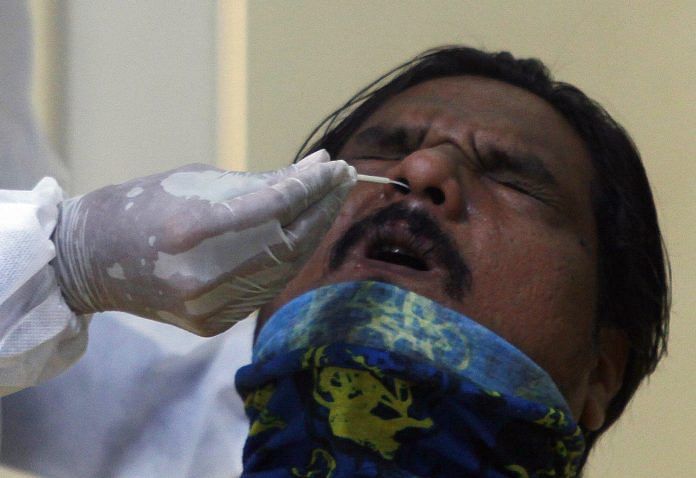India went into a lockdown when there were about 519 Covid-19 cases in the country. Now, that number has risen to 20,000 and is doubling approximately every week.
So, by the time the lockdown ends in May, the number could quadruple. Given the stringent testing criteria and the limited availability of testing kits, inevitably there will be undetected positive cases. Even if we make a very conservative assumption that the number of positive cases that have missed testing is only one per cent of the total Covid-19 cases — which could quadruple to 80,000 in May — there will about 800 infected people who will be freely moving about when this lockdown ends.
This means that the number of infectious people in public will be more at the end of the lockdown than it was before it began. So, the curve of infected people will grow as it would have grown if there was no lockdown — only now, it is delayed.
While the Covid-19 lockdown gave us time to prepare for the crisis, clearly the growth of infection must be avoided. The goal must be to beat the coronavirus. And for that, special steps will have to be taken. To understand the problem, and the approaches that can be used, let us use a simple model.
Also Read: 30 days in lockdown, India has been able to control rate of Covid-19 infections, says govt
Categorise population
When the lockdown restrictions are lifted, because Covid-19 testing is not vast and comprehensive in India, there will be people in the public who will be carrying the virus. In other words, we will have three categories of people — ‘Q’, infected people in quarantine; ‘C’, people who are in public and infected with coronavirus; ‘N’, people who are not infected.
If the quarantine is effective, people in the Q category will not infect anyone further. This requires measures to ensure that caregivers of quarantined people do not get infected. Those in the N category will also not infect anyone. The only group that can infect others is the C group.
Standard epidemiological principles say that in order for the disease to die down, we need to ensure that the C group infects on an average less than 1 person each. If they infect more, then the pandemic will continue to explode at an exponential rate. The rate of growth is based on the average number of people a carrier infects, called the reproductive number (R0), which depends a lot on the social structure and environment that determine interactions. If R0 is 1 then the disease becomes endemic and stays within a limited number of people infected by it at any given time — like most other diseases.
As we may not know after the lockdown who are the ones in C group and cannot distinguish them from those in the N group, the government and the population need to take special measures in order to keep the R0 number less than 1.
Also Read: Reduce cost of business, reform land acquisition — BJP suggests plan for post-Covid economy
Measures to reduce R0
The government needs to take two steps to reduce the R0 number — social distancing and early detection.
Wearing masks should be made compulsory for all when they are in public. This will minimise the incidents of coronavirus carriers infecting others, and will also protect healthy people from getting infected. Early detection of an infected person, followed by a strict quarantine, will also help India keep the R0 number low.
The first step is obvious and all the countries will apply it when they lift their lockdowns. Coupled with strong messaging, compliance should be there as this is also in the interest of individuals. For India, the second step will mean a change in our current strategy. It will require educating people so all have the right awareness to identify early symptoms of Covid-19 disease in themselves and in family members, friends and neighbours.
The fine balance between raising enough awareness while mitigating panic will need to be achieved. This underscores the importance of initiatives such as Aarogya Setu and WashKaro. Other methods to identify symptoms early can also be put in place.
Importantly, anyone with early symptoms will need to be rapidly tested, and quarantined if found positive. This will require a change in testing approach and reach. If this is not done, India will run the risk of multiple waves of spread whenever R0 overshoots 1. It should be emphasised that as infected persons may remain asymptomatic or develop the symptoms late, the first step will need to be followed strictly – rapid and extensive testing alone will not solve the problem.
However, most importantly, given the number of unrecognised and asymptomatic infections, the lasting solution to this crisis is behavioural. Social and technological solutions that can induce behavior change must be sought out and made pervasive to effectively minimise the spread through the unknown people in the C category.
Otherwise, the impact of lockdown, after incurring huge economic and human cost, would be confined to delaying the spread of coronavirus, not reducing it.
Pankaj Jalote is a Distinguished Professor and Tavpritesh Sethi is an assistant professor at Indraprastha Institute of Information Technology, Delhi. Anurag Agarwal is the director of Institute of Genomics and Integrative Biology. Views are personal.



